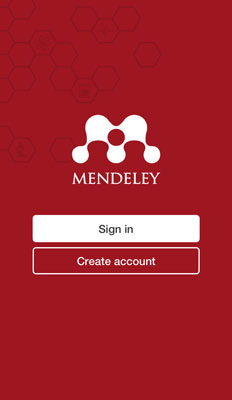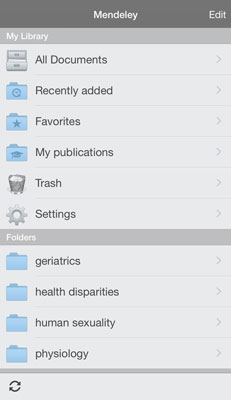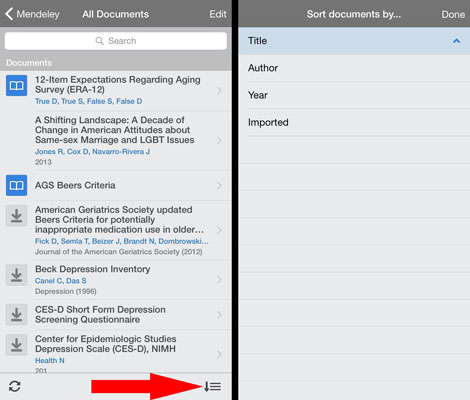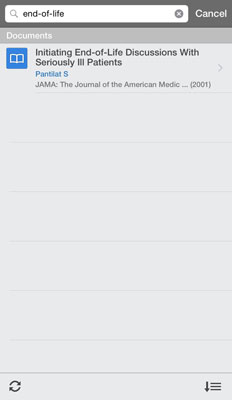Download the app and sign in.

Source: mendeley.com
You’ll find Mendeley Mobile is now available all the popular smart device formats: Windows, iOS, and, as of June 2015, Android. Download it to your device and log in with your Mendeley account information just as you would on the Desktop or Web version.
Take (or skip) the tour.

Source: mendeley.com
The first thing to appear is an offer for a tour of the app. Sometimes these mobile app tours are pretty worthless. This one is short and somewhat helpful, so go ahead and buzz through it if you wish (swipe left to move to the next screen). Otherwise, just tap Skip to get to work.
Get to know the main interface.

Source: mendeley.com
If you’re already familiar with Mendeley Desktop, this main view of the mobile app will be familiar: it is essentially the folder list that runs down the left side of Mendeley Desktop. In the top section are your automatically generated folders (Recently added, Favorites, etc.). At the bottom are the folders you created for sorting your documents. Tap any of these to see what’s inside them.
In the bottom left corner is the Refresh button. Tap this button to sync your mobile library with your online account.
Mendeley Mobile does not currently support creating new records or importing files or records. That is likely to change in a future version, since so many people now use their mobile devices exclusively and don’t use a desktop computer.
Sort the library.

Source: mendeley.com
When you’re in a folder viewing library records, you’ll find the Sort button at the lower right. Tap Sort and you’ll be presented with four ways to sort the folder: by title, author, year or the date you imported items to the library.
Search for a record.

Source: mendeley.com
If you have holes in your citation data and you need to do some research about your research, it’s helpful to know that you can edit records in Mendeley Mobile. You don’t need to lug around anything so elaborate as even a pencil and paper — make the changes directly to the record on your phone or tablet and sync it to your account’s library.
Find the record quickly by typing a key word into the Search box at the top of the screen. Tap a record to open it for review or editing.
Hide, delete, or add items.

Source: mendeley.com
From the main Mendeley Mobile screen, tap Edit. From here, you can work with your fiddle with your files and folders in a variety of ways:
In the My Library section, the checkmarks next to the folders means they are visible in the app. If you want to hide one of them (say, My publications, if you don’t have any of your own), tap it to remove the checkmark. This move has no effect on the actual contents of the folder. Repeat this move to show it again.
In the lower Folders portion of the screen, you see the list of folders you created in your account. Any folder that can be deleted will have a red dot next to it. Tap the red dot to get rid of any folder and all of its contents. When asked, tell Mendeley if you want to move it to the trash or just remove it from the Mendeley library.
When you’re in a folder, swipe left on a record to delete it from the library.
If the existing folders are not enough, add a new one. Tap + and provide a name, then tap Create folder. You can also tap the + button when you’re in an existing folder to create a subfolder.
Tap Done at the top right when you’re finished fiddling.
Edit a record.

Source: mendeley.com
Tap a record to open it, then scroll down the page to see what all the record contains and, more importantly, what is missing that you need to include for your citation or for the bibliography. (The requirements vary depending on what citation style you are using.)
Once the record is open, you can make changes to any of the fields on the page.
Whatever information appears here is exactly how it will appear in your research paper — including typos and misspellings. Always double-check your work. When you’re finished editing, tap Save.
Refresh your Word document when you get back to your desk, and presto! The holes in those citations and bibliography are now magically filled in. Thank you, Mendeley cloud!
Download a PDF.

Source: mendeley.com
Speaking of the cloud, Mendeley will store all of your library’s PDFs in your account cloud so you can download one document at a time. You don’t have to use up precious space on your mobile device. You can store up to 2 GB in the Mendeley cloud for free, and additional library space is available at a reasonable monthly charge if you need more room.
This is not the same as the space required to store documents on your device, which could be much more or much less, depending on your device.
If a document is in the cloud, the Download symbol will appear next to the record; if the document is already downloaded to the device, the Document symbol will appear. Tap a downloaded document to open it.
Read, search, and annotate a PDF.

Source: mendeley.com
Got a few minutes to kill while you’re waiting for the shuttle? If you want to stay productive, you can use the PDF reader in Mendeley Mobile to read, highlight, and make notes in your research documents.
To select what you want to annotate, press and hold to place the cursor in the document, and then drag to select the desired text. A toolbar will appear above the selected text, from which you can:
Tap the Highlight button (T) to add yellow highlight to the selected text.
Tap the text bubble to add a note or comment you might want to follow up on later.
Tap Define to look up the definition of a word, either via a downloadable dictionary or via a web-based dictionary.
In any open document, use the Search bar to find specific information within the file. It works just as you suspect it might.
Be sure to tap Refresh before you leave Mendeley Mobile to ensure all your notes and highlights are saved to the cloud and updated on other devices.






